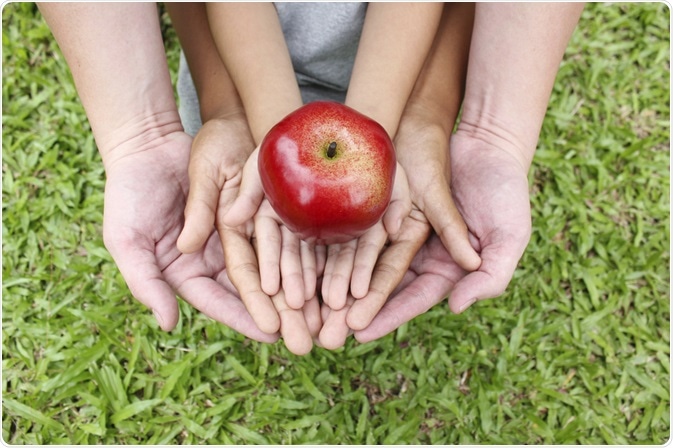The severe impacts of climate change are becoming increasingly visible. Average air temperatures are increasing, oceans are becoming warmer, ice caps are melting and the sea levels are rising. Farmers are struggling to grow enough crops because their land is being devastated by more intense droughts and extreme weather conditions.

Image Credit: paulaphoto/Shutterstock.com
The Earth’s beautiful biodiversity is threatened by the changing climate, which is rendering habitats unlivable for an increasing number of species.
If significant action is not taken, heat waves, hurricanes, floods, shifts in animal ranges, and widespread crop failures will become more commonplace. Here, we discuss how these shifts in weather patterns are negatively impacting global food security.
Climate change factors that influence food security
Climate change has a significant impact on a multitude of factors that influence agriculture. Average temperatures, for example, are on the rise globally. In arid and tropical regions, this increase is often detrimental to crop yields.
Similarly, global precipitation is increasing, however, this is not affecting all areas equally. Some regions will have more rainfall, and others will have less. This uncertainty causes problems for farmers. Additionally, rain-fed agriculture stands to suffer from decreases in rainfall or unpredictable patterns, which can cause crops to fail.
Extreme weather events are becoming more common, with droughts, floods, and cyclones occurring more frequently and with more ferocity. Such events can trigger cycles of poverty and hunger, the loss of crop yields in the wake of an extreme weather event can prevent a community from recovering. Droughts, in particular, are predicted to continue to increase in frequency, intensity, and duration. Droughts almost always end in agricultural losses, especially in arid and semi-arid areas where millions of people are already suffering from hunger and are reliant on crop yields.
Temperature is vital to crop development; even mild heatwaves can destroy a crop if they coincide with key stages of development. Heatwaves are predicted to become more common and hotter in the coming years.
On the other hand, heavy rain and flooding are also becoming more common, which can have an equally detrimental impact. This type of weather event can also destroy entire crop yields, as well as vital food stores.
Tropical storms and cyclones can cause the widespread destruction of crops, land, and agricultural infrastructure. While a significant percentage of annual rain in tropical regions comes from cyclones, the increasing frequency of these events is having a devastating impact on food security.
Increasing sea levels threaten to flood agricultural land. Additionally, the melting glaciers that contribute to rising sea levels also impact river systems by increasing the seasonal pattern flow. This is troublesome to agriculture as it means that water availability becomes dependent on snowfall and rainfall.
Finally, climate change is exacerbating the prevalence of particular illnesses, such as respiratory illness and diarrhea. This threatens food security in two ways. First, in communities stricken by these illnesses, there can be a significant loss in labor productivity, and, therefore, crop production. Secondly, the diseases reduce people’s ability to absorb nutrients from food, thus making it necessary to consume greater quantities of food.
Data is already coming to light to provide strong evidence for the impact of climate change on food availability. For example, the National Geographic recently published figures that predict that by 2050, corn crop yields will have reduced by 24%, rice by 11%, potatoes by 9%, and wheat by 3%, all due to climate change. Because crops like soybeans, wheat, rice, and corn currently provide two-thirds of the food the global population needs to survive, these dramatic reductions in crop yields over a time where the world’s population is expected to increase present a major problem for future food security.
Another study estimates that since 1982, the world’s total crop yield had dropped by 70% even though the demand for food has increased significantly.

Image Credit: Arthimedes/Shutterstock.com
How will we feed the growing population?
By 2050, the world’s population is predicted to have grown from 7.8 billion (2020 global population figure) to 9.9 billion. It will require global food production to increase by at least 60% to accommodate this growing population. These figures demonstrate the urgent need to address climate change in order to mitigate its detrimental impact on food security and ensure that future generations have access to sustainable agricultural processes that guarantee enough food will be produced each year.
Already, scientists are developing ways to enhance crop production (other than tackling climate change, the source of the problem itself) such as the use of sensors and the Internet of Things (IoT) to facilitate precision agriculture.
Other innovations such as vertical farming have also begun to take off, where a greater volume of crops can be produced without needing to acquire more land for farming. Scientists are also exploring ways to tackle food waste so that every plant harvested is eaten and nothing is wasted.
These innovations and more will be fundamental to tackling food insecurity as the population grows and the impact of climate change continues.
Sources:
- (2021). [Online]. Climate Change-Related Disasters a Major Threat to Food Security - FAO. UNFCCC. Available at: unfccc.int/.../climate-change-related-disasters-a-major-threat-to-food-security-fao (Accessed 11 October)
- Effects of Climate Change. [Online]. WWF. Available at: https://www.worldwildlife.org/threats/effects-of-climate-change (Accessed 11 October)
- Extreme Weather and Climate Change. [Online]. Available at: Center for Climate and Energy Solutions. Available at: https://www.c2es.org/content/extreme-weather-and-climate-change/ (Accessed 11 October)
- Impacts on food security. [Online]. Met Office. Available at: www.metoffice.gov.uk/.../impacts-on-food-security (Accessed 11 October)
- Raza, A., Razzaq, A., Mehmood, S., Zou, X., Zhang, X., Lv, Y. and Xu, J., 2019. Impact of Climate Change on Crops Adaptation and Strategies to Tackle Its Outcome: A Review. Plants, 8(2), p.34. https://www.ncbi.nlm.nih.gov/pmc/articles/PMC6409995/
Further Reading
Last Updated: Dec 14, 2021